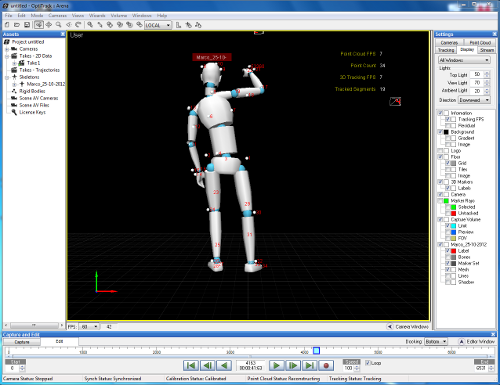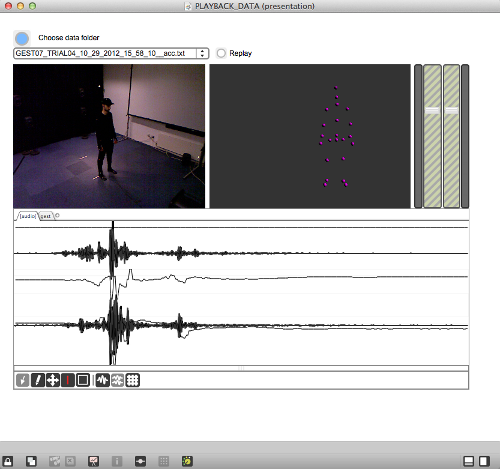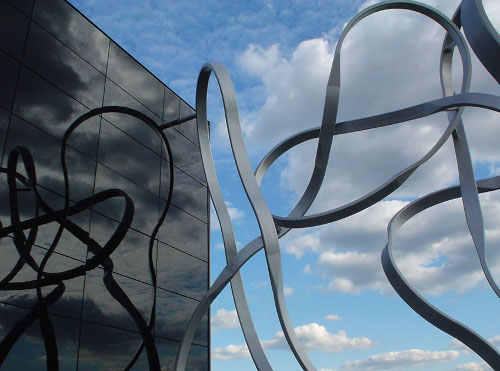Archive for February, 2013
Combining biophysical and spatial modalities for musical expression
I kicked off my PhD studies by extending the Xth Sense, a new biophysical musical instrument, based on a muscle sound sensor I developed, with spatial and inertial sensors, namely whole-body motion capture (mocap) and accelerometer. The aim: to understand the potential of combined sensor data towards a multimodal control of new musical interface.
An excerpt from our related paper:
“In the field of New Interfaces for Musical Expression (NIME), sensor-based systems capture gesture in live musical performance. In contrast with studio-based music composition, NIME (which began as a workshop at CHI 2001) focuses on real-time performance. Early examples of interactive musical instrument performance that pre-date the NIME conference include the work of Michel Waisvisz and his instrument, The Hands, a set of augmented gloves which captures data from accelerometers, buttons, mercury orientation sensors, and ultrasound distance sensors (developed at STEIM). The use of multiple sensors on one instrument points to complementary modes of interaction with an instrument. However these NIME instruments have for the most part not been developed or studied explicitly from a multimodal interaction perspective.”
Together with team colleagues Baptiste Caramiaux and Atau Tanaka, we designed a study of bodily musical gesture. We recorded and observed the sound-gesture vocabulary of my performance entitled Music for Flesh II.
The data recorded from the gesture were 2 mechanomyogram signals (MMG or muscle sound), mocap data, one 3D vector from the accelerometer, and 3D positions and quaternions of my limbs.

My virtual body performing Music for Flesh II, as seen by the motion capture system.
We created a public multimodal dataset and performed a qualitative analysis of those data. By using a custom patch to visualise and compare the different types of data (pictured below) we were able to observe complementarity of different forms in the information collected. We noted 3 types of complementarity: synchronicity, coupling, and correlation. You can find the details of our findings in the related Work in Progress paper, published for the recent TEI conference on Tangible, Embedded, and Embodied Interaction in Barcelona, Spain.

The software we developed to visualise the multimodal dataset.
To summarise, our findings show that different type of sensor data do have complementary aspects; these might depend on the type and sensitivity of sensor, and on the complexity of the gesture. Besides, what might seem a single gesture can be segmented into sections that present different kind of complementarity among the different modalities. This points to the possibility for a performer to engage with richer control of musical interfaces by training on a multimodal control of different types of sensing device; that is, the gestural and biophysical control of musical interfaces based on a combined analysis of different sensor data.
New directions
Picture by carolineld.blogspot.com
Here we are. Last post is dated September 2012.
A lot has happened since then, and here is a brief update.
I’ve just moved to London and started working with a newly-formed research team headed by Prof. Atau Tanaka (US/UK), including as of now, Baptiste Caramiaux, Alessandro Altavilla, and myself. We are investigating a broad notion of gesture (musical, physical, and biological gesture) and music performance. The outcome is the creation of new musical instruments that bring together biosensing technologies, spatial sensors, and custom machine learning methods for a corporeal performance of sounds and music. The instruments should be for musicians and non-musicians alike, wearable, and redistributable.
The project is called Meta-Gesture Music (MGM) and it is funded by the European Research Council (ERC). Our team is based at the Computing department, Goldsmiths, University of London, and is part of EAVI, a larger team of investigators, musicians, artists, and coders dedicated to Embodied Audio-Visual Interaction.
The Xth Sense project continues and I will keep posting about new developments. Meanwhile, the MGM research is a great chance to draw from the experience of the XS, and evolve the theoretical and technical framework developed so far.
Regular updates on our work will follow regularly, so feel free to come back and see what we are up to.


